Dec 25, 2025
Dec 25, 2025
The Slavic Glory of Eurasia
Continued from Previous Page
Slavs are the largest ethno-linguistic group of people inhabiting a large part of Eurasia encompassing Central, Eastern, North and Southeastern Europe, stretching further east into Northern Asia (Russia and Siberia) and parts of Central Asia, particularly Kazakhstan and Turkmenistan. It is believed that their history starts from early 6th century and by now a good number of people of Slavic origin are found in the countries like US, Canada, Brazil, etc. as well. Among them, the largest population of the people of Slav origin is among the Russians (nearly 135 million), and other significant population over 10 million and above is among the Ukrainians, Poles, Czechs, Serbs, Belarusians and Bulgarians.
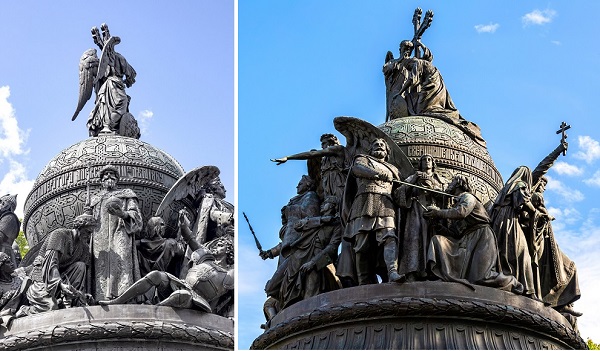
The majority of Slavs are now Christians by faith introduced by the missionaries during the Byzantine empire or even atheist/agnostic (about 13%) after the advent and spread of communism in these areas in the twentieth century. The author intends to discuss a brief history with associated details, traditional religion and deities chiefly in the context of Russians which not only constitute the largest ethnic group of Slavic origin but also accredited as the largest country in the world with an area of about 17.13 million km square.
A Brief Civilizational History of Slavs (Russia)
In the ancient Roman accounts, the early Slavs have been referred to as Veneti inhabiting parts of the Central Europe east of the Germanic tribe Suebi and west of Persia during the first and second centuries CE. Then even more pronounced description of Slavs as Antes and Sclaveni people appears in the Byzantine empire records of the early sixth century CE. Till late 19th century, only four Slavic states namely the Russian Empire, and the Principalities of Serbia, Montenegro and Bulgaria were in existence. During the 20th century, after the World War I and fall of the Central Powers, more Slavic nations like Poland, Czechoslovakia, and Yugoslavia emerged. Then following the end of the Cold War and collapse of the erstwhile USSR in 1991, several new Slavic countries such as Russia, Ukraine, Belarus, Slovakia, Slovenia, Croatia, Bosnia, Herzegovina, Serbia, Montenegro, North Macedonia, and Czech Republic were formed. However, here we shall discuss only the evolutionary history of the Russians, the largest and most prominent people among the Slavic constituents.
Archaeological records and carbon dating suggest the presence of human settlements in the Russian land since the early Lower Palaeolithic period. Some skeletal fossil records of Neanderthal (Homo neanderthalensis) and Pithecanthropus (Homo erectus) have been found, the latter possibly migrated to northern Caucasus areas from the West Asia. Similarly, traces of the modern man Homo sapiens were found in the Central Siberia. Apparently, in the prehistoric periods the steppes of the Southern Russia were occupied by the nomadic pastoralists. As mentioned in previous paragraph, the early Roman records mention Slav tribes as Veneti, Antes and Sclaveni in these parts. During the 3rd/4th centuries CE, evidence of a Gothic kingdom exists in the Southern Russia, later destroyed in Hun’s invasion. In subsequent period, constant migrations of nomadic tribes are reported including the Vikings from Scandinavian countries. It is widely opined that some ancestors of the modern Russians were definitely of Slavic tribal origin. The early East Slavs are believed to have overwhelmed the Russian land in two waves towards Kiev and Novgorod by the 7th century, the bulk population of the Western Russia was comprised of the Slavs having comfortably blended with the native Finnic tribes.
The period 882-1283 CE is marked as the advent and decline of the Kievan Rus’ in the Russian history. During the 9th century, the Scandinavian Norsemen, known as the Vikings in Western Europe and Varangians in the Eastern regions, dominated many parts of Europe from Baltic to Black & Caspian Seas. Around 860 CE, a Varangian Ruric established his rule in Novgorod and his son Igor and grandson Sviatollav gradually including Kiev too subduing all Slavic tribes replacing the Khazars. The Kievan Rus’ controlled all trade routes for the furs, wax and slaves between the then Scandinavia and the Byzantine Empires. With the growing influence of Christianity, the Kievan Rus’ also introduced a Slavic Eastern Orthodox religion as a hybrid of the Byzantine and Slavic cultures wherein the Russian Church and State were closely linked. During the 11th century CE, the Kievan Rus’ had made significant progress in economy, architecture and literature particularly during the rule of Yaroslav the Wise. However, the nomadic Turkic invasions kept constantly bothering the Kiev administration. Besides, the members of the princely family had constant in-fighting among themselves in their collective rule. Gradually, the influence of Kiev Rus’ declined abdicating many areas and influence to the neighbouring Halych-Volhynia, Vladimir-Suzdal and Novgorod. Finally, Kiev was destroyed during the Mongol invasion in the 13th century CE and absorbed into the Polish–Lithuanian Commonwealth while the latter two neighbouring states referred to above laid the foundation of the modern Russian nation.
From the beginning of the 13th century till late 15th century, Russians face constant invasions and threat from Mongols. At occasions, the invaders inflicted heavy damages and even almost completely destroyed Kiev. Under their threat, the Russians learnt and drastically revised their military strategy, transportation and communication network. Daniil Aleksandrovich, the youngest son of Alexander Nevsky of Novgorod, founded the well protected principality of Moscow in 1287 CE at the banks of the central river system with dense cover of forests and marshes. Initially, it served as a vassal state of Vladimir but later it absorbed the parent state within self. Its influence was further enhanced after Moscow became the nucleus of the Russian Orthodox Church and was one time visualized as new Rome. Moscow Principality’s leadership gradually consolidated in Russia through the instruments of war, purchase and marriage, and its influence expanded over the vast areas by the middle of the 14th century CE. Also, the Moscow Principality cooperated with the Mongols initially but later Dmitry Donskoy considerably succeeded in minimizing Mongol influence leading to eventual expulsion from Russia in due course.
Ivan III, the Great was the most competent and influential ruler in Moscow in the 15th century, who is credited with laying of the foundation of the Russian national state. He had succeeded in subduing the Grand Duchy of Lithuania and annexing Novgorod, Tver and many smaller Principalities of Dnieper and Olga River basins. His 1472 CE marriage with the Byzantine Princess Sophia Palaiologina too considerably strengthened his political position and his encounter with Tatar in 1480 on Ugra River effectively ended Mongol rule from Russia. Soon Ivan III proclaimed absolute sovereignty over all Russian princes and nobles and by the onset of the 16th century the entire Russian territory was proclaimed as collective property of rulers in Moscow in the context of military, judiciary and foreign affairs. During his time, he was able to triple his territory with a strong military and sound economic status. The famous heritage building Kremlin and a seat of major tourist attraction was also built during his reign. Gradually, he emerged as all powerful and autocratic ruler - a Tsar. However, this was his successor Ivan IV who officially crowned himself as Tsar.
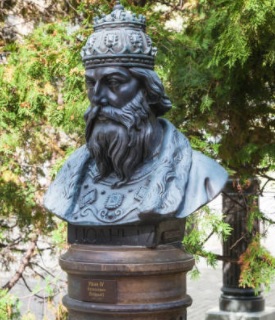 Ivan IV, often remembered as Ivan the Terrible, acted as the Grand Prince of Moscow in initial years and then "Tsar of Russia" until his death in 1584. He is so designated because he arbitrarily assumed enormous powers for self, ruthlessly subdued all the princes and nobles and got people executed at the slightest provocation. His ruthless rule experienced the Massacre of Novgorod in 1570, several military losses, epidemics and constant poor harvests that considerably weakened Russia. Towards the end of his reign, the Polish–Lithuanian and Swedish armies attacked Russia and caused severe damages in its northern and northwest regions. Ivan IV was succeeded by his son Feodor who remained childless and his death plunged the Russians into civil war and foreign interventions leading to vast instability for nearly two decades. The Russia, however, survived the “Times of Trouble” and the reign of corrupt and weak Tsars largely owing to the strength of its rather efficient and effective central bureaucracy till early 18th century.
Ivan IV, often remembered as Ivan the Terrible, acted as the Grand Prince of Moscow in initial years and then "Tsar of Russia" until his death in 1584. He is so designated because he arbitrarily assumed enormous powers for self, ruthlessly subdued all the princes and nobles and got people executed at the slightest provocation. His ruthless rule experienced the Massacre of Novgorod in 1570, several military losses, epidemics and constant poor harvests that considerably weakened Russia. Towards the end of his reign, the Polish–Lithuanian and Swedish armies attacked Russia and caused severe damages in its northern and northwest regions. Ivan IV was succeeded by his son Feodor who remained childless and his death plunged the Russians into civil war and foreign interventions leading to vast instability for nearly two decades. The Russia, however, survived the “Times of Trouble” and the reign of corrupt and weak Tsars largely owing to the strength of its rather efficient and effective central bureaucracy till early 18th century.
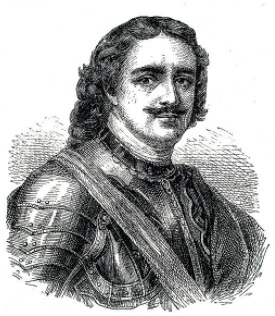 The Tsardom of Russia finally ended when Peter the Great laid the foundation of the Russian Empire in 1721 CE by assuming the title of an emperor. He played a major role in transforming his huge country on the pattern of the European state system, which now stretched from the Baltic Sea to the Pacific Ocean. Peter was one to create the Russian Navy, staged a military expedition against the Ottoman Turks and his ambition to secure a window to the sea led to the Russian Great Northern War with Sweden. The war ended in 1721 when humbled and exhausted Sweden desired for peace and Peter was able to acquire access to the sea through the Gulf of Finland. This suited his plan as the city of the Saint Petersburg had already been created in 1703 to replace Moscow as the Russian capital. Emperor Peter is also accredited with reorganizing his government on the Western models, in the process he even replaced the old boyar Duma (council of nobles) with the supreme council of state comprised of nine members. The country was also reorganized into new provinces and districts. Although Peter the Great died leaving behind a great empire without deciding succession but he was succeeded by the second wife Catherine (1725-27 CE) without much ado. During the next few years, the Russia experienced quick change of rulers in a war of intrigue and succession until Elizabeth, daughter of Peter I became empress in 1741 and ruled till 1762, during which Russia too participated in the Seven Years’ War between Great Britain and France for the global pre-eminence.
The Tsardom of Russia finally ended when Peter the Great laid the foundation of the Russian Empire in 1721 CE by assuming the title of an emperor. He played a major role in transforming his huge country on the pattern of the European state system, which now stretched from the Baltic Sea to the Pacific Ocean. Peter was one to create the Russian Navy, staged a military expedition against the Ottoman Turks and his ambition to secure a window to the sea led to the Russian Great Northern War with Sweden. The war ended in 1721 when humbled and exhausted Sweden desired for peace and Peter was able to acquire access to the sea through the Gulf of Finland. This suited his plan as the city of the Saint Petersburg had already been created in 1703 to replace Moscow as the Russian capital. Emperor Peter is also accredited with reorganizing his government on the Western models, in the process he even replaced the old boyar Duma (council of nobles) with the supreme council of state comprised of nine members. The country was also reorganized into new provinces and districts. Although Peter the Great died leaving behind a great empire without deciding succession but he was succeeded by the second wife Catherine (1725-27 CE) without much ado. During the next few years, the Russia experienced quick change of rulers in a war of intrigue and succession until Elizabeth, daughter of Peter I became empress in 1741 and ruled till 1762, during which Russia too participated in the Seven Years’ War between Great Britain and France for the global pre-eminence.
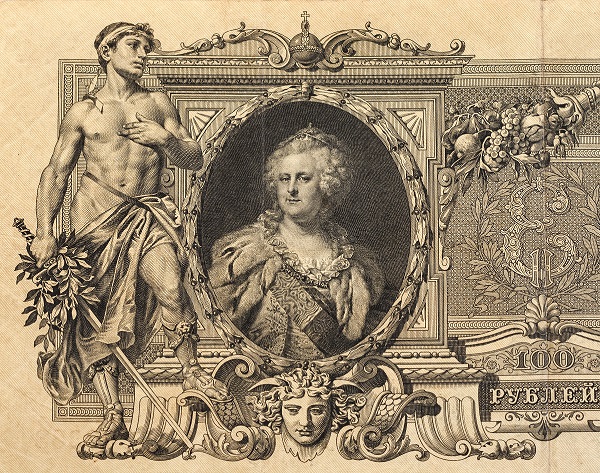
Russian Empire banknote 100 rubles fragment.
Version of 1910 year.
Front with portrait of Catherine the Great.
Catherine II (1762-96 CE) became queen regnant overthrowing own weak and incompetent German husband and heir to the Russian crown in 1762. She whole heartedly patronized learning, arts and science, promoted Russian nobility during her regime and exercised tight control over the Church activities. Her expansive foreign policy and oppressive social system provoked a major peasants’ uprising in 1773 which was brutally crushed by her regime. She also had two successful wars against Ottoman Empire extending the Russian boundary to the Black Sea. All these actions earned her the title of ‘Catherine the Great’. After her death, Alexander I continued her expansionist policies from 1796 onward and captured Finland from Sweden and also more territories of Ottoman empire. His period was marked with intense battle, several ups and down among the Major European powers for supremacy and he was able to finally defeat Napoleon in 1814-15 with either side incurring huge losses. During the years of long conflict, Alexander emerged as the 'Saviour of Europe' and presided over redrawing the map of war-torn Europe.
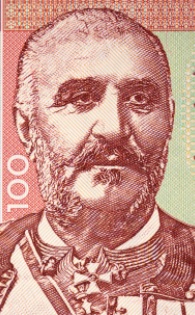 Alexander I was succeeded by the younger brother Nicholas I (1825–55 CE), who had to immediately face the Decembrist Revolt by a group of liberal nobles and army officers who wanted constitutional reforms to end the traditional autocracy in Russia. During the next three years, Russia had war with Persians which was finally won by them on favourable terms gaining more territories. However, the Crimean War towards the end of his rule proved that Russia had been disproportionately investing on military and wars over the years which had, in fact, rendered it militarily and economically weak, technologically backward and administratively incompetent. When Alexander II came to the throne in 1855, the major problem confronting the Government was serfdom with about 23 million serfs in a total population of 67 million. Alexander introduced reforms in judiciary, abolished serfdom, promoted local self-government, rationalized privileges of nobility, promoted education and introduced universal military service. Besides, he sold Alaska to the United States in 1867 and modernized the military command system. His son Alexander III ((1881–94 CE) reversed some of his father’s policies and tried to revive orthodoxy, autocracy and national character. During his reign, he forged a treaty with France to contain growing German power and conquered parts of Central Asia exacting certain commercial and territorial concessions from China.
Alexander I was succeeded by the younger brother Nicholas I (1825–55 CE), who had to immediately face the Decembrist Revolt by a group of liberal nobles and army officers who wanted constitutional reforms to end the traditional autocracy in Russia. During the next three years, Russia had war with Persians which was finally won by them on favourable terms gaining more territories. However, the Crimean War towards the end of his rule proved that Russia had been disproportionately investing on military and wars over the years which had, in fact, rendered it militarily and economically weak, technologically backward and administratively incompetent. When Alexander II came to the throne in 1855, the major problem confronting the Government was serfdom with about 23 million serfs in a total population of 67 million. Alexander introduced reforms in judiciary, abolished serfdom, promoted local self-government, rationalized privileges of nobility, promoted education and introduced universal military service. Besides, he sold Alaska to the United States in 1867 and modernized the military command system. His son Alexander III ((1881–94 CE) reversed some of his father’s policies and tried to revive orthodoxy, autocracy and national character. During his reign, he forged a treaty with France to contain growing German power and conquered parts of Central Asia exacting certain commercial and territorial concessions from China.
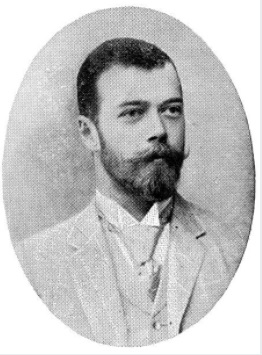 Nicholas II (1894-1918 CE) succeeded to throne following the death of his father Alexander III in 1894. This was the time when the industrial revolution and many social reforms had considerably changed the face of the Western Europe and were simultaneously exerting considerable pressure on the Russian system too for the change. Politically, many liberal elements among the Russian capitalists and nobility wanted peaceful social reforms and constitutional monarchy, who formed the Constitutional Democratic party or Kadets in 1905. However, even before this development, the Narodnik traditions had already constituted the Socialist-Revolutionary Party or Esers in 1901, favouring the rational distribution of land among the peasants. Another radical group, an exponent of Marxism, had founded the Russian Social Democratic Labour Party (RSDLP) in 1898 itself. These parties had started raising voices for the complete social, economic and political revolution garnering support from the radical intellectuals and urban working class. The RSDLP split into two wings in 1903: One, the radical Bolsheviks, headed by Vladimir Lenin; and the other moderate Mensheviks, led by Yuli Martov. Needless to mention, as against Menshevik’s agenda of gradual and peaceful change, the Bolsheviks were keen to act as the vanguard of the proletariat to capture power through application of force.
Nicholas II (1894-1918 CE) succeeded to throne following the death of his father Alexander III in 1894. This was the time when the industrial revolution and many social reforms had considerably changed the face of the Western Europe and were simultaneously exerting considerable pressure on the Russian system too for the change. Politically, many liberal elements among the Russian capitalists and nobility wanted peaceful social reforms and constitutional monarchy, who formed the Constitutional Democratic party or Kadets in 1905. However, even before this development, the Narodnik traditions had already constituted the Socialist-Revolutionary Party or Esers in 1901, favouring the rational distribution of land among the peasants. Another radical group, an exponent of Marxism, had founded the Russian Social Democratic Labour Party (RSDLP) in 1898 itself. These parties had started raising voices for the complete social, economic and political revolution garnering support from the radical intellectuals and urban working class. The RSDLP split into two wings in 1903: One, the radical Bolsheviks, headed by Vladimir Lenin; and the other moderate Mensheviks, led by Yuli Martov. Needless to mention, as against Menshevik’s agenda of gradual and peaceful change, the Bolsheviks were keen to act as the vanguard of the proletariat to capture power through application of force.
An incident recorded in history as the “Bloody Sunday” occurred in January 1905 when the Winter Palace guards in Saint Petersburg opened fire killing hundreds of people in a crowd gathered to give a petition to Emperor Nicholas II. This incident triggered the beginning of the Russian Revolution of 1905.
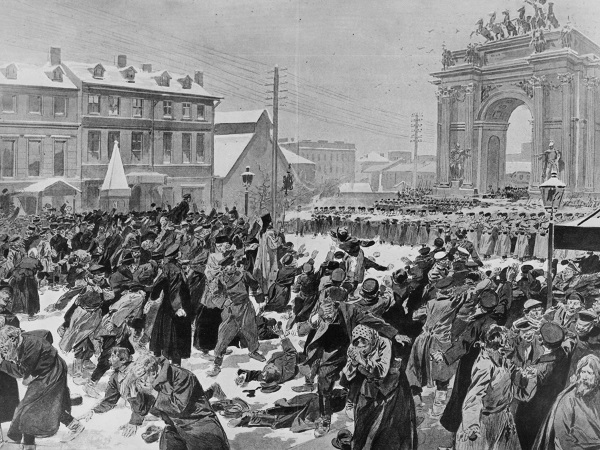
Nicholas II reluctantly agreed to issue the October Manifesto allowing creation of the Duma (Legislature)at the national level that satisfied many moderates but the radicals continued their struggle. As they too were not united, hence the Tsar (Emperor) rule continued for the time being. However, the struggle with demands for the radical reforms continued which ultimately led to a bloody Civil War (1917-22) in Russia. As for the fate of Nicholas II, the revolution started in February 1917 and by March 1917 it became so strong and violent that the emperor had to abdicate the throne abolishing and ending three centuries rule of the Romanov dynasty. Later, the emperor died in July 2018. These developments provisionally paved absolute powers to the Duma under Prince Lvov, which declared formation of the government of the Russian Republic. However, Bolsheviks under Lenin forcibly dissolved it and a bloody civil war in Russia started, coterminous with the World War I, and continued for years in which lakhs of people were killed before an autocratic communist government under Vladimir Lenin was formed in 1922 declaring Russia as the Union of Soviet Socialist Republic (USSR), an arrangement that continued till 1991.
Ancient Slavic (Russian) Religion: Gods and Goddesses
Like most other civilizations, Slavs were polytheistic following their own gods and goddesses. Although the civilizational evolution in Slavic regions and the spread of Christianity in the majority Slavic areas were almost simultaneous during the first millennium, the Slavic mythology and gods and goddesses along with their traditional beliefs remained still popular among people for a considerable period. The gods and spirits as also associated religious beliefs and traditions varied among the Slavs from region to region. Such details are better known from a 12th century document called the Novgorod Chronicle chiefly detailing the traditions of Kievan Rus’. As on date, many documented Slavic myth and religious texts or prayers are not available or lost with main information source being the Christian chroniclers. Although Russia produced several great writers and poets during the later history with rich literature, but not much is known about the universality of the early Slav pantheon and associated deities. However, about a dozen better-known gods and goddesses are briefly mentioned here. Under the influence of Christianity and Communism, only a little over 1% Russians people still believe in their ancient pagan religion.
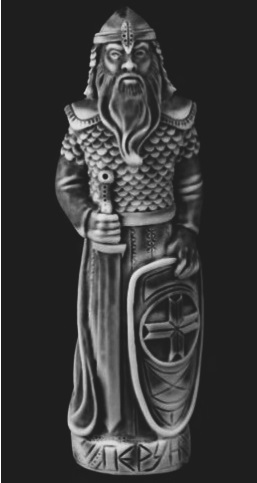 1. Perun
1. Perun
Perun was the highest deity in the Slavic pantheon and popularly known as the god of thunder. He was associated with sky, thunder, lightning, rain, storm, war, law, fertility and oak tree. He is depicted to carry weapons such as hammer, axe and arrow comprised of stones and metal as well. His other attributes include mountains, fire, wind, iris, eagle and firmament. He was widely worshiped across the Slavic Europe; in fact, the artifacts, toponyms and traditions suggest that the cult of Perun was widespread among the Slavic, Baltic and Finnic states, the latter recognizing him as Perkunas. He was broadly considered as the reigning god of heavens, lightning and thunder. He was associated with the sacred oak tree and Slavic people considered it symbolic world of all beings with top branches symbolized as heavens, trunk and lower branches as earthly realms of human beings and the roots as underworld. As ruler of sky, earth and entire living world, Perun was often symbolized by a majestic eagle in motifs overseeing the universe from the top of the tallest branch of the sacred oak tree. A large number of shrines and temples existed for his worship in high places like mountains and groves of oak trees.
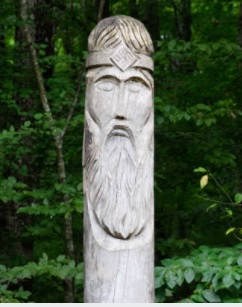 2. Dazbog
2. Dazbog
Also known as Dahzbog, Dzbog or Dazhd'bog, he was the god of sun in-charge of fortune, happiness and justice in the pre-Christian Slavic culture of which all mainstream Russian people too belonged. In hierarchy of gods, he comes only next to Perun and some people even worshipped him as the supreme deity. He was the son of god Svarog, husband of Mesyats (moon goddess) and brother of famous fire god Svarozhich. He was believed to travel across the sky in a golden chariot drawn by fire-breathing horses of white, gold, silver and diamond hues. According to the Slav myth, Dazbog lived in east in a palace made of gold with eternal summer. He had daughters together known as Zorya representing the morning and evening auroras; The morning Zorya would open the palace gates to enable Dazbog to commence his daily voyage across the sky while the evening Zorya would allow him entry before closing the gates at the fall of dusk. The sun god always carried a solar fire shield as a constant source of sunlight.
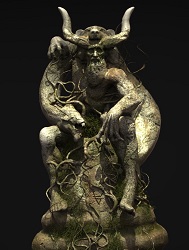 3. Veles
3. Veles
Veles, also known as Volos, was the Slavic god of earth, waters, livestock, storms and underworld. In mythology, he was depicted as an arch enemy of god Perun and a frequent shapeshifter, hairy and dark god with his expertise in magic, sorcery and trickery. In several pagan beliefs, he was also depicted as chimeric serpent devouring livestock or dragon accused of stealing family members of Perun and hiding them in the underworld. People made offerings to him out of fear, he was known to punish oath-breakers with diseases, and his favourite tree was the willow. Veles’ rivalry and enmity with Perun is described in many Slavic folklore and songs, the cause of a mythical battle between the two gods being the former’s act of challenge by stealing and hiding the latter’s son and wife. In the ensuing battle, Perun attacked him with thunderbolts and in defence, Veles fled and hid at various places transforming self in various forms of dragon, animals, trees and human beings. In iconography, he is at times depicted as serpent slithering up the sacred tree in Perun’s domain.
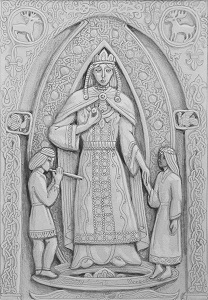 4. Lada
4. Lada
Lada is the spring goddess of beauty and love in the Slavic mythology with mass following. In many Russian folklore and songs, she is described as an extremely beautiful and gracious lady with white skin, golden brown hair with crown on her head representing an embodiment of the divine charm and everlasting youth. People considered her as the patron of wedding and accordingly invoked her along with twin Lado to shower blessings on the newly wedded couple. Some Slavic groups even worshipped her as the mother goddess and supreme female deity mainly because of her indulgence with love, matrimonial bliss, fertility, being guardian of women, children and fruitful harvests. In certain parlance, she is even compared with the Greek goddess Aphrodite and Scandinavian goddess Freyja particularly in the context of human desire and eroticism. In many mythical legends, Lada and Lado are depicted as female and male divine twins or even as companions or Lado as offspring in different versions. The two together also represent ‘duality’ in some accounts of Slavic pantheon with Lado representing as an infernal god in sharp contrast to Lada.
5. Belobog and Czernobog
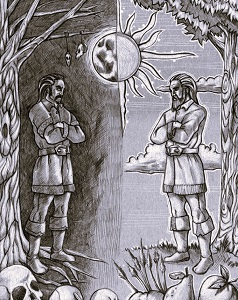 They are complimentary or symbolic gods of good and bad of the Polabian Slavs. The Belobog or Bielbog (white god) represents the god of auspicious fate, the nomenclature arguably derived as analogous description to the Chernobog (Black God) or Czernobog mentioned by Helmod in his work Chronica Slavorum, who is supposed to be a god of bad luck. The two complimentary yet opposite gods are often taken by the scholars as the evidence of "dualism" in Slavic culture. The polar opposite gods, particularly, Czernoblog, had a mass following among the Slavic people across the world but according to another scholarly view, they were essentially two different aspects of the same god. Much credible information is not available but Czernobog is generally considered as a dark and cursed deity associated with bad luck, calamity and death; also, the reasons why he was more worshipped. In certain myths, he is even depicted as a demon indulging in all sorts of evil actions and doings. There are many conflicting views among the scholars and experts about the cult of Chernobog and Belobog, including the one that they may not have been gods but merely a hypostasis of evil and good.
They are complimentary or symbolic gods of good and bad of the Polabian Slavs. The Belobog or Bielbog (white god) represents the god of auspicious fate, the nomenclature arguably derived as analogous description to the Chernobog (Black God) or Czernobog mentioned by Helmod in his work Chronica Slavorum, who is supposed to be a god of bad luck. The two complimentary yet opposite gods are often taken by the scholars as the evidence of "dualism" in Slavic culture. The polar opposite gods, particularly, Czernoblog, had a mass following among the Slavic people across the world but according to another scholarly view, they were essentially two different aspects of the same god. Much credible information is not available but Czernobog is generally considered as a dark and cursed deity associated with bad luck, calamity and death; also, the reasons why he was more worshipped. In certain myths, he is even depicted as a demon indulging in all sorts of evil actions and doings. There are many conflicting views among the scholars and experts about the cult of Chernobog and Belobog, including the one that they may not have been gods but merely a hypostasis of evil and good.
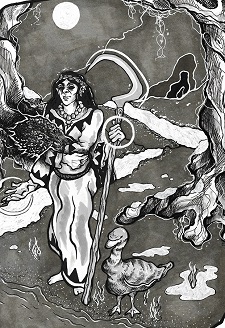 6. Marzanna
6. Marzanna
Marzanna, the goddess of winter and death, is remembered with multiple names in Slavic regions such as Marena among Russians, Marzanna among Polish, Mara among Ukrainians, and More, Morana, Morena and Mora in other Slavic countries. In conventional iconography, she is depicted as a pale skin and black-haired woman with fangs and claws, somewhat similar to popular Russian mythical character of Baba Yaga witch. She is often compared with the Roman goddess Ceres and Greek goddess Hecate. As the goddess of death, her realm was underworld and represented long, harsh winter bringing death to many humans and cattle due to freezing and starvation. This Slavic goddess is linked with the idea of season-based death and rebirth of the nature. Accordingly, in different Slavic regions, the rite of the death of Marzanna is performed towards the end of winter paving way for the rebirth of the spring goddess Lada, Kostroma (Russian) or Vesna in the form of the arrival of the Spring season. In such rituals usually performed around the spring equinox, the effigy of Marzanna is burned or drowned to symbolize the cycle of the life, death and rebirth. In the modern age, she is merely used as personification of winter and her symbolic drowning as the end of this season.
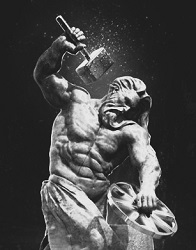 7. Svarog
7. Svarog
Svarog is remembered as the god of fire and blacksmithing in the Slavic pantheon, who is sometimes compared with the Greek god Hephaestus. As one of the early gods and the father of Dazbog, Svarozhits and some gods and goddesses, he is also referred to as the creator and sky god. He finds mention in the ‘Tale of Bygone Years’ which is also known as the Russian Primary Chronicle or just the Primary Chronicle. In some Slavic versions, he is depicted as a very powerful god who created the world while in one version, he is blended with Perun to create an almighty fatherly god. According to one mythical legend, Svarog is always asleep and his dreams are responsible for the creation of the realm of human beings, and if he would ever awaken, the world of human beings would collapse.
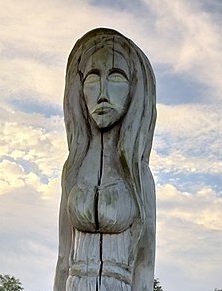 8. Mokosh
8. Mokosh
As one of the mother goddesses, Mokosh was considered a fertility goddess in-charge of the safety and protection of women during the child birth, their destiny and work, including the spinning, weaving and shearing of sheep. In the parts of Eastern Europe, many people still worship her as the guardian of women and a life-giving force. In iconography, she is depicted as a graceful lady with uplifted hands flanked by two plow horses. After Christianization of the Kievan Rus’, the cult of Virgin Mary gradually replaced her. In Eastern Slavs, she was also known as Mokos, Mokosa or Mokusa in different parts.
9. Zorya
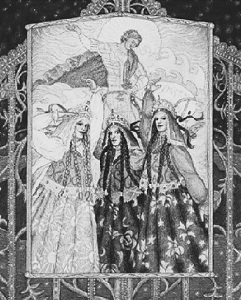 Zorya is the goddess of the dusk and dawn with several variants in different Slavic regions with people knowing her as Zarya, Zara, Zaranitsa or Zoryushka. She is depicted as the daughter or twin daughters of the sun god Dazbog. Accordingly, subject to the tradition in different parts, she appears both as a singular goddess "The Red Maiden" or twin sister goddesses representing the dawn and dusk. In either case, the goddess(es) lived in the palace of the sun god and opened and closed gates for his exit and entry to enable him to carry on with his daily chorus. For instance, in Russian traditions, Zorya appeared as the two virgin sisters: Zorya Utrennyaya (Morning Aurora), as the goddess of dawn, and Zorya Vechernyaya (Evening Aurora), as the goddess of dusk. They would stand guard on different sides of the golden throne of Dazbog and the two Zoryas would open and close palace gates at the sun rise and sun set for him, respectively, to facilitate the journey of sun god. Similarly, different Slavic countries such as Belorussia, Ukraine, Poland, etc., followed their own beliefs and traditions about the goddess.
Zorya is the goddess of the dusk and dawn with several variants in different Slavic regions with people knowing her as Zarya, Zara, Zaranitsa or Zoryushka. She is depicted as the daughter or twin daughters of the sun god Dazbog. Accordingly, subject to the tradition in different parts, she appears both as a singular goddess "The Red Maiden" or twin sister goddesses representing the dawn and dusk. In either case, the goddess(es) lived in the palace of the sun god and opened and closed gates for his exit and entry to enable him to carry on with his daily chorus. For instance, in Russian traditions, Zorya appeared as the two virgin sisters: Zorya Utrennyaya (Morning Aurora), as the goddess of dawn, and Zorya Vechernyaya (Evening Aurora), as the goddess of dusk. They would stand guard on different sides of the golden throne of Dazbog and the two Zoryas would open and close palace gates at the sun rise and sun set for him, respectively, to facilitate the journey of sun god. Similarly, different Slavic countries such as Belorussia, Ukraine, Poland, etc., followed their own beliefs and traditions about the goddess.
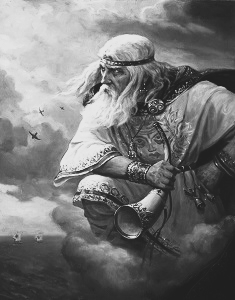 10. Stribog
10. Stribog
In Slavic mythology, Stribog finds mention in several East Slavic sources mostly as the wind god who apart from taking charge of the wind also had a function of distributing wealth among the human beings. Though he did not appear to have much following among the Slavic people, he finds a mention in the Russian Primary Chronicle along with other prominent gods whose statues were erected by Vladimir the Great in his time.
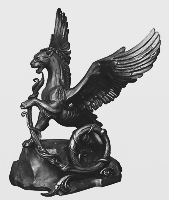 11. Simargl
11. Simargl
Simargl or Semargl was more like a mythical creature often depicted as a winged lion or even dog in the East Slavic mythology. His wife is Kupalnitsa, the goddess of night, and the daughter Kostroma, a fertility goddess. According to a myth, the Zorya sisters keep him chained to the star Polaris in the constellation Ursa Minor so that he does not break free to destroy the constellation, because it it happens, the world would collapse.
12. Rod
 Popular as Sud (meaning judge) in the Southern Slavic regions, Rod is the god of the ancestors, family and fate. In some areas during the first millennium, his cult existed as the Supreme god during the age of patriarchal agricultural societies but was later replaced by Perun. In many Slavic areas, usually the first haircut (postriziny) of the child was dedicated to him along with a special meal.
Popular as Sud (meaning judge) in the Southern Slavic regions, Rod is the god of the ancestors, family and fate. In some areas during the first millennium, his cult existed as the Supreme god during the age of patriarchal agricultural societies but was later replaced by Perun. In many Slavic areas, usually the first haircut (postriziny) of the child was dedicated to him along with a special meal.
Slavic (Russian) Mythology: Legends and Myths
The civilizational ancient history of Russia and allied ethnic world is not as old and glorious as those of the Roman, Greek, Persian or Indian civilizations. The chief reason was possibly the late migration and settlement of human groups in these regions due to harsh climatic and weather conditions. When a large-scale human settlement started in Slavic regions, the Christianity had already emerged as a dominant religion in Rome (Italy) with considerable following in Greece, two most evolved civilizations of Europe at the time. Therefore, while the polytheistic beliefs and traditions evolved in these regions but with a considerable influence of the Christianity as dogmatic religion. Accordingly, many Slavic gods and goddesses appear to have somewhat similar attributes like those of the Roman and Greek deities. The old Russian literature appears to be rich in folklore and fairy tales instead of presenting much literature or details about the pantheon, gods and goddesses. Even the creation myths of Slavs appear to have considerable Christian influence. A few popular and representative myths and folk tales are briefly summarized here.
1. Slav Creation Myth
It is reasonably certain from the reliable historical accounts that the human civilization developed late in the parts of the northern globe including the Western Europe and Eurasia towards later part of the first millennium CE. Accordingly, the Slavic mythology and the creation tale reflect considerable influence of the mythological traditions of the earlier civilizations in Europe and Asia. The Slavic mythology has three versions of the creation myth: the first one is the so-called earth-diver concept comprised of the dualistic motif of creation by the cooperation between the (good) God, the Devil (bad god) and the pre-existing water (ocean); the second one talks about the creation of universe from the Cosmic Egg and World Tree; the third one which is not as pronounced and popular as the previous two is about the creation from a primordial being. The interesting feature of various creation tales remain that the reference of oceanic water or the cosmic egg is invariably found and even scientists agree that the first life was originated in sea water.
|
Carpathian Carol It used to be at the beginning of the world – |
For the sake of brevity, we will talk about just one myth here in the context of the creation from the Cosmic Egg narrated in a poem found in the “Carpathian carol” by Alexander Nikolayevich Afanasyev, a famous Russian Slavist and ethnographer of 19th century, who perhaps has the largest collection of folklore and fairy tales to his credit. Here Carpathian is a mountain range in Eurasia and carol refers to a song. According to this theory, in the beginning there was neither sky nor earth in the universe; instead, there was just the blue oceanic water everywhere. In the middle of the water, one oak tree existed on which two cosmic pigeons sat in a cheerful mood and mooted a scheme for the creation of the world. They decided to get into the bottom of the sea to bring up the fine sand and blue pebbles. The fine sand was sown from which originated the earth, potable water and green grass while from the blue was created the blue sky, bright sun, moon and all the stars.
In the aforesaid carol, one can essentially observe three elements viz. two pigeons perched on a huge oak tree, fetching of the fine sand and blue pebbles by these birds, and the creation of the cosmogenic world. In the Slavic literature, two pigeons, hens or such other birds, or even bees, sitting in the top of the tree is a very popular motif often representing the World Tree. Here the World Tree symbolizes the "navel of the world", which is supposedly tall, wide and heavy. Here the aforesaid description metaphorically suggests that the God planted his staff into the water to convert it into a huge world (Oak)tree. The two pigeons sitting in a conference on its top actually represent God and the Devil who take plunge in water to create the world out of the sea water. The cosmic egg or world egg as conceptualized in other creation theories is represented here by the fine sand and blue stones, which become the progenitors of the earthly objects and celestial bodies. Thus, this Slavic myth broadly concord with the other myths of the Cosmic Egg where it is broken down whereby the lower shell leads to the formation of earth and the upper shell into the sky and other heavenly bodies.
2. Myth of Firebird
In Slavic folklore, the Firebird is a prophetic and magical glowing bird of a faraway land that comes as a blessing to some people as well as harbinger of doom to others. In one narrative, Maryushka was a gentle and orphan girl in a small Russian village. She produced good embroidery work which was in great demand fetching her enough money for a good living. Many merchants tried her to persuade for going to city and work for them but she refused to leave her village. One day an evil sorcerer ‘Kaschei the Immortal’ came to know about her fascinating needlework and became very envious that an ordinary mortal could master such an art and skill. He transformed self into a handsome prince and made a proposal to her for a marriage provided she agreed only to embroider for him. When she refused to leave her village, he transformed her into a Firebird and self as a huge black Falcon. While he was abducting her away from the village picking her in his talons, she kept shedding her feathers below in sorrow and memory of the motherland. After shedding her last feather, Maryushka died and her feathers were immortalized as glowing and magical rainbow feathers which showed colours to only those onlookers who loved beauty and appreciated beauty of others.
Yet another connected folklore is about the Firebird and Princess Vasilisa. In this story, an archer finds the Fire Bird’s feather during a hunting session which he picks up despite own horse’s warning about a bad omen. On return, he presented the beautiful feather to the king who demanded him to catch the whole bird alive for him else face a death penalty for self. Fearing for life, he put corn in the field on his horse’s advice, the Firebird indeed came to eat corn and was captured and presented to the king by the archer. Now the king demanded that the archer must also bring Princess Vasilisa as he wanted to marry her, failing which he will have to die. The archer went to princess’s land, somehow tricked and drugged her to bring to king’s palace. When pressed for the wedding, Vasilisa demanded her wedding dress which was hidden under a rock in the Blue Sea. The archer once again sought his horse’s assistance and was successful in recovering the wedding dress from the Blue Sea. Now the princess was adamant that the archer must be dipped in the boiling water before the marriage ceremony is performed. However, the horse applied a protective lotion on the archer that not only saved him from the boiling water but he also emerged as a very handsome and young warrior. Now the king too jumped in the boiling water in the hope of regaining youth and handsome personality but he was instantly boiled in hot water and killed. The handsome archer was now incarnated as the king, married to the princess and the two lived happily ever after.
3. The Princess with Hair of Gold
Once upon a time, a wise and clever king ruled in the Far East. One day an old woman with an odd-looking fish approached the king’s palace and sought a private meeting with the king. Once admitted, she presented the fish to him with an advice to get it cooked and eat it full; once eaten, he will be able to understand the language of all creatures. However, while cooking it, the king’s personal servant and cook George got suspicious and ate a part of fish himself before serving it to the king despite the latter’s strict order not to taste it. Soon George realized that by eating a part of fish, he could now understand the language of flies, birds and other creatures around. Having dined well with fish, the king ordered George to saddle two horses and give him company on a ride. While the two horses were conversing, George heard some unsoliciting words from the mouth of the horses about the king’s age and poor health and could not but stop his smile. The king got suspicious and back in palace, he ordered George to serve him wine and make sure that it does not overflow else he will be punished. While pouring wine, George heard two birds quarrelling over the possession of three golden hairs of a beautiful princess carried in their beak. In their melee, one golden hair fell down upsetting the curious George and thus the wine got spilled over the glass.
Now the king was convinced that the servant has eaten parts of fish and can understand the language of animals. The furious king scolded George for disobeying his orders of not tasting the fish; however, he agreed to show mercy provided George brings the princess with the golden locks to make his queen. Poor George was willing to do anything for his life but he had no knowledge about the whereabouts of the princess. He, however, mounted his horse and left it to the horse’s will wherever it takes him along. During the onward journey through a dark forest, George happened to help and save lives of a large number of ants and their eggs from the bush fire and a pair of young starving ravens by offering meat of his own horse. In turn, the ants and ravens thanked him and told him to ask for their help in distress. Now without horse, George had to travel on foot finally reaching to the sea shore where he settled the dispute between two fishermen over the possession of a large golden fish. By buying the fish in return of his entire money, he saved the life of fish which assured him help in gratitude whenever he was in need. Besides, the two fishermen not only gave him clues about the Princess Zlato Vlaska with golden locks but also agreed to ferry him to the remote island.
On reaching the island, George wasted no time to contact the king seeking hands of the princess for his master and king. In return, the king of island set three conditions one by one to be met for allowing Princess Zlato Vlaska to marry George’s master king. The first task was the recovery of fine pearls of the princess scattered and lost in the great grass field, the second task was finding her golden ring dropped into the deep sea, and the third one was to fetch the Water of Death and the Water of Life. George had no idea how to accomplish these tasks; however, with the assistance of the ants, golden fish and ravens, he was able to accomplish all the three tasks within the allotted time. While returning after completing the third task, he saved the life of a fly from the giant spider’s web, which later assisted George in identifying the Princess Zlato Vlaska among the twelve daughters of the king veiled under similar head dresses. Having seen the beauty and splendour of the princess with wonderful golden hair, George instantly fell in love with her.
The king showered all kinds of costly gifts to Princess Zlato Vlaska worthy of a queen with permission to go with George. The return voyage was safe and eventless, and the old king was delighted to have beautiful princess in his palace. However, he had not forgotten George’s betrayal about unsolicited sharing of the secret of the animal language; hence the only favour he granted him was a graceful burial after execution. After the capital punishment was carried out, the princess begged the king to hand over George’s dead body to her. She immediately put the severed head of George in its right place and sprinkled the Water of Death. The separated parts were united, then she sprinkled the Water of Life on the dead body. Consequently, George became alive with more vigour, radiant face and youthful body. Seeing George so alive and fresh, the king too had cravings to become young and handsome, so he ordered his servants to severe his head and sprinkle the charismatic waters on his body. The servants cut off his head and poured all the remaining water but the king never returned to life again probably owing to some mistake. Now George was proclaimed the new king and the Princess with the golden hair became his queen. The two lived together a blissful life for long.
4. Baba Yaga
In Russian folklore, Baba Yaga is a very popular character as a witch, which often spooks and scares people, especially the children. In some versions, she is depicted as a single and old spinster while in others is found living with the daughter Marinka or Marina. Her abode is usually a wooden hut at the edge of the forest with no windows or even door in some narratives. The surrounding fence is depicted with human bones and skull with one pole without it suggesting a wait for the next victim. She is mostly shown as an ugly, unclean and evil old woman with a huge distorted nose and long teeth. In other version, she acts like a guardian at the entry into the wild wood. She does not allow anyone to pass without teasing or testing their endurance and nerves. Those who pass her test and found worthy enough are allowed to have passage in the woods and even helped with her talisman while people failing her test are punished. She uses her characteristic giant broom to travel or chase her victims and enemies with the common antics of turning young from the old in a blink of eyes. One tale associated with her goes as under.
A long time ago, there lived a man with a kind and beautiful daughter named Vasilisa in the village near Baba Yaga’s forest. Before death, her mother had given her a doll with an advice to look after her well with a little milk and biscuit every day. As the time passed, Vasilisa’s father remarried and had two more daughters with the second wife. Her step mother and step sisters, however, were evil and jealous of her, although in her father’s presence they pretended to love her. They kept threatening Vasilisa that they would show her place in the family once father ever goes out for long. When she turned to the age of sixteen years, one day her father decided to go out on a month-long business tour. On the very first day of his departure, the step mother called all the three sisters in the night: While she gave easy tasks of stitching and pastry preparation to younger girls Tanya and Katya but Vasilisa was asked to go to Baba Yaga’s hut to borrow some lights for their house. Scared Vasilisa kept talking to her little doll about the possible harm from the old witch but the doll told her to be brave to face every situation. While on way, she heard the sounds of galloping hooves on three occasions behind her and every time a rider, each in red, white and black cloak, respectively, quickly went pass her.
Vasilisa easily recognized the cottage of Baba Yaga stood on chicken legs with blazing skulls mounted on top of a high fence near the fence of woods. Baba Yaga with her long bony nose appeared on the door holding a broom stick with her feet few inches high in the air and curtly questioned Vasilisa who she was and why she was there. Mustering courage, she could barely tell her about the step mother’s command to borrow a light from her. Her attire and courteous tone moved the old witch a little and she told the girl to come in the hut and address her as Babushka (Grandma). Once admitted inside hut, Baba Yaga, however, told her to perform certain tasks successfully before she decides to lend her a light. First day, Baba Yaga asked the girl to clean the hut and cook pumpkin soup for her supper and that was an easy task for Vasilisa. Next morning, Vasilisa got scared to see the old witch flying up the chimney, onto the roof and then on trees like a giant mortar. The following day, she was expected to carry out rather impossible task of sorting out black peas out of a huge sack with white ones. While worried about the task, Vasilisa noticed white horseman outside window for a blink and found the peas were already sorted out in separate white and black piles. In the evening, Baba Yaga appreciated her effort with some surprise and gave her next task of making pea soup and fetching water from the nearby stream in sieve to fill her tank.
That day Vasilisa was really scared of failing the task and thereby incurring the wrath of old witch but her doll told her not to worry and work without fear. That day the red horseman appeared for a short while in the yard, took her sieve and hurled it through the window and to her surprise the tank was filled with fresh water. The witch was even more surprised but gave her the next task to count exact number of stars with the condition that the success will fetch her the desired light and in the event of failure, the witch will eat her for the breakfast. During the night, Vasilisa tried time and again but remained unsure about the count with the hut constantly moving and view of the sky constantly kept changing. She was scared but her doll told her not to worry and keep her faith intact. Then while sitting near the window, the black horseman appeared and whispered a big number in her ear to tell the witch in the morning. Baba Yaga instantly knew that the girl was helped by the Morning, Day and Night in her tasks. She was impressed and now knew that Vasilisa was indeed a good girl, so she gave her a skull with blazing eyes in the evening and let her go. Vasilisa went back to her village; when she entered the house, the skull lit up making it bright like the day with her step mother and sisters instantly turning into dust. Thereafter, Vasilisa lived with her father without any trouble and one day a prince came to marry and take her to his palace.
5. The Frog Princess
The Frog Princess is yet another fantasy folklore in Russian way of life since long The protagonist character is worthy of a perfect spouse, who is not only wise, beautiful and sensible but also very loyal, resourceful and frugal. However, the most remarkable feature of the Frog Princess is her skill in the magic arts and the fact that she is assisted by a battery of nannies under her command, always willing to come for help in all situations. Princess’s story has many fantasy moments and magical events. The sad part of the tale is that her own father caused her to turn into a frog as punishment for a certain period and even compelled her to appear in the same avatar with the prospective groom – the crown prince Ivan. Besides, when Ivan made a mistake of burning her frog skin, he was made to undergo an enduring trial to win the confidence of her love interest back. The story briefly goes as under.
A king wanted his three sons to get married with the worthy prospective brides; so, to accomplish this task, he organized a simple test to find brides. Each of the princes were asked to shoot an arrow and find their bride where their arrow had landed. The youngest Prince Ivan's arrow fetched a frog. Now the king assigned several tasks like spinning, weaving, baking, and so on to all prospective daughters-in-law and the frog outperformed the human brides in all assigned tasks. Now the young Prince Ivan was married to the frog but he was ashamed of his frog bride until it revealed her true identity of a beautiful princess. The Frog Princess Vasilisa used to take form of a beautiful woman during the night and remained in the frog skin in the day time. One day, Prince Ivan burned her frog skin but lost the princess in this process. Consequently, Prince Ivan had to undergo many rigorous trials and tests, and finally he succeeded in freeing the Frog Princess from her curse and the two together lived happily again.
Tailpiece
The ancient civilizations in the old-world realm had mostly developed in Asia, Africa and Southern Europe although the fossils of early human species have been reported from many parts in the world including Russian Siberia and Caucasus regions. These fossil occurrences suggest the adventurous nature and attributes of the humans to explore and learn since beginning, but late arrival of the nomadic human groups, settlement of tribes and further evolution as the developed societies in the parts of the northern hemisphere including Russia and other countries was possibly owing to the harsh climatic conditions for the survival in these regions. The ancient history of Slavs (Russians) is not as old and pronounced as those of Greeks and Romans of the Southern Europe but it is evident and remarkable that despite the advent of Christianity and its aggressive spread in various regions much before the arrival of Islam, even the vast region of Slavic denominations in Eurasia had freely evolved and practiced their own pantheon, rituals and traditions, albeit under the considerable influence of the dominant Abrahamic religion prevailing at the time.
Images (c) istock.com, Wikipedia and Web
13-Feb-2022
More by : Dr. Jaipal Singh